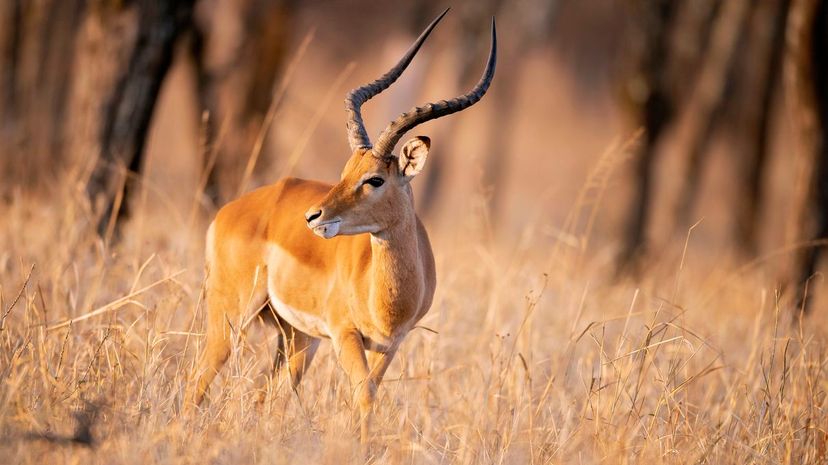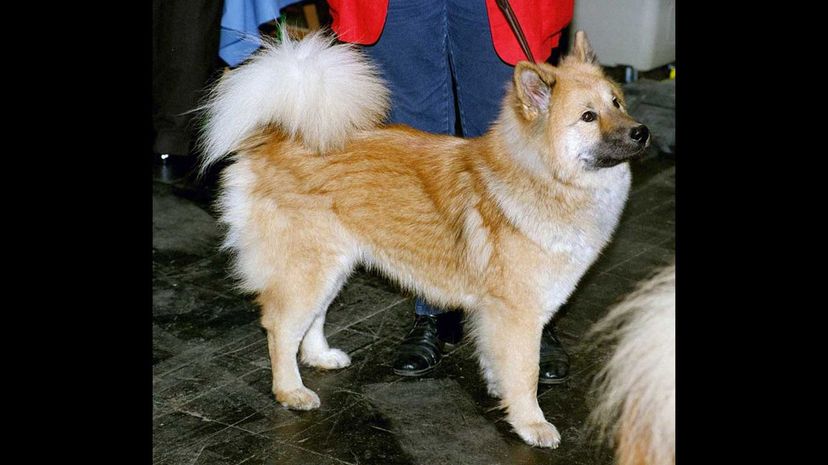
About This Quiz
Word is there are over 8.7 million different species of animals in the world. 8.7 million! If you averaged that out, there'd be at least 330,000 animals for every single letter of the alphabet. And you know there aren't that many that begin with X or with Z, either. There have to be a whole heck of a lot of animals out there whose names start with the letter "A."
And it poses a kind of interesting question, doesn't it? How many animals can you think of that start with one specific letter? How many "A" animals could you pull out of thin air? Sure you could probably name 10 off the top of your head with no trouble whatsoever. Give it a second, and you could easily get up to 20 different ones, right? But how easy would it be to think of 30 different animals? And then, if you achieved that goal, could you get all the way to 40?
If you think you have the zoological and alphabetical skills to handle it, why not step into our Alpha Zoo and see how many of these "A" animals you can identify. After all, how hard can it be? It's just one letter.

Armadilloes are omnivores, and they're more recognizable by their leathery hide, which protects them from predators and the elements. There are a few species of armadillo out there including the very unusually pink fairy armadillo, which is only about 3 to 4 inches long and loves to burrow.

Alligators and crocodiles have a lot in common, but the average alligator is smaller than a crocodile. Despite their smaller size, they can hit speeds of around 15 miles per hour when they're motivated, which makes them very hard to escape even on land.

The albatross has the largest wingspan of any bird in the world, and they also fly like it's their job. These birds have been observed covering incredible distances of up to 75,000 miles in a single year. It looks like they need all that extra wingspan to keep moving.
Advertisement

There are actually over 140 species of anchovy out there but, for the most part, they're all very tiny fish found in ocean waters. While most people associate them with a salty pizza topping, they get used as a flavoring in many other dishes such as Caesar salad dressing and Worcestershire sauce.

The aardwolf gets its name from the Afrikaan language where it means "earth wolf." Why an earth wolf? Because they burrow and live underground, which is a bit unusual for what looks like a dog. They also eat termites and other insects, which is part of the reason they burrow so much.

There's no reasonable way to know how many ants exist in the world, but you can make some educated guesses. One such estimate puts that number at about 10,000 trillion ants, which is such a preposterously high number it's not even worth thinking about.
Advertisement

Antelopes can be found on several continents and are typically very deer-like in appearance. Unlike deer and other members of that family, the horns of an antelope will never branch. They grow as a single horn, and they also serve as one of the primary food sources for most African predators.

Anacondas are arguably one of the most famous snakes in the world thanks to a curious pop culture fascination with them. Not only do they appear in lyrics from Sir Mix-A-Lot and Nicki Minaj but there's an entire series of horror movies about them.

The domestication of the Abyssinian cat dates back to Ancient Egypt when these cats were traded along the Nile River. They can trace their roots to wild cats, and maybe that's part of the reason this breed, to this day, is still a little rambunctious and active.
Advertisement

Axolotls are sometimes called "walking fish" even though they are, in fact, amphibians. They're also very much endangered since much of their natural habitat was lost due to urbanization, pollution and the fact that people like to eat these little guys.

The African clawed frog gets its name from the fact that, unlike any other frogs, this little guy legit has claws on its front feet. The claws are used to burrow and also to climb or shred prey. Sadly, these little animals have also been used extensively in medical research, such as in the development of pregnancy tests.

The aye aye was actually thought to be nearly extinct as recently as the 1980s as locals tend to kill them on sight as they're considered unlucky. They were also notoriously hard to categorize and have at different times been considered squirrels or lemurs. They're neither of those things, incidentally. An aye aye is its own unique category.
Advertisement

The largest Asiatic black bear will weigh around 300 pounds and, unlike most other bear species, their upper body is much stronger than their hindquarters. This is a result of their arboreal lifestyle and the fact they climb trees like champs. So basically don't try to box one or you'll lose.

Australian cattle dogs are extremely active and make poor pets if you can't keep up with them. If they can't work, they're well suited for doing things like agility or other dog sports. Basically, anything that lets them focus their energy on a task.

Asian elephants are smaller than their African relatives, but can still weigh upwards of 4 tons. They also face many of the same dangers from habitat loss and poaching that African elephants do and, unfortunately, they are unable to live as long in captivity.
Advertisement

Sometimes called a snow fox or a white fox, the Arctic fox can survive in temperatures that get as cold as minus 50 degrees Celsius, which works out to about -58 degrees Fahrenheit. Their incredible fur coat is what keeps them insulated enough to survive the harsh Arctic weather.

Most people probably recognize anglerfish from movies like "Finding Nemo," but they do look like that nightmare in real life thanks to that mouth full of horror-movie fangs that curve inward to help it grasp its prey.

The Asian giant hornet is a disturbingly large insect with a body about 2 inches in length. An entomologist once described the sensation of being stung by one of these hornets as being similar to having a hot nail driven into your flesh. Stings can be lethal, even to those not allergic.
Advertisement

The Aldabra tortoise is one big beast with males growing to over a meter in length and upwards of 500 lbs in weight. It also has an unusually long neck, which allows it to pluck leaves from branches on bushes and trees that would be much too high for the average tortoise.

Even though they look a little like a cat, the African palm civet is more closely related to the mongoose. They also have an abundance of scent glands on their abdomen and between some of their toes to ensure they're always able to pungently mark their territory or attract a mate.

Unlike some dog breeds, the origins of the Akita are still a bit mysterious. We know they come from Akita Prefecture in Japan but the reason why can be debated. Some believe they are hunting dogs, while others believe they were bred as fighters.
Advertisement

The Airedale terrier is the result of cross-breeding Otterhounds and Welsh terriers. It's the largest of all terrier breeds and was originally bred for its hunting prowess at tracking down little pests like rats.

Adelie penguins and Emperor penguins are the two species you'll find in the Antarctic. Adelie penguins are the smaller ones and are probably some of the most recognizable birds in the entire world thanks to movies like "March of the Penguins."

The Australian Mist is a cat quite obviously from Australia that has been bred since sometime in the 1700s. They're very friendly cats and make excellent pets thanks to their even temperament and call, Australian attitude.
Advertisement

Anteaters are one of those animals that got named or a pretty obvious reason; they like to eat ants. Their long snout houses an even longer tongue that's actually longer than their entire head. Their mouths also have no teeth in them, so they never get to chew those tasty bugs they eat.

Also called an Appenzeller Sennenhund, this breed dates back to at least 1853. Their purpose is to work as a farm dog and, in more specific terms, to herd and guard sheep. Hey, someone has to do it.

Native to the Congo Basin, Allen's swamp monkey is pretty much what the name implies - a monkey from the swamp. As a result of their living conditions, they're actually quite handy at swimming and can even dive underwater to avoid danger.
Advertisement

The Amazonian manatee is from the Amazon Basin and can be found in rivers throughout Peru and Brazil. Unlike a lot of mammals, the manatee doesn't have canine teeth or even incisors. All it has are molars, so it's really good at chewing things up.

Arctic hares are famous for their blinding white coat which helps them vanish into the snowy plains of the Arctic in winter. During the summer months, the hare's coat is brown so it can still blend into its surroundings.

As the name indicates, the Anatolian shepherd dog was bred to guard sheep. As one of the largest shepherds out there, its particular purpose was to be more of a guard dog than a shepherd, which means these dogs can be a bit difficult to deal with if they're not well-trained.
Advertisement

The American kestrel is the smallest falcon in the North American continent and also the most common. The name sparrowhawk comes from the fact it can and will hunt sparrows, but its diet is usually things like small lizards and grasshoppers.

The American bullfrog is common all over North America and is one of the largest species of frog in the world. The name comes from the fact that at least someone in history felt the sound a bullfrog made was very much like the sound a bull made.

Pit bulls have long been considered the most dangerous breed of dog in the world, but especially in North America. This stems in part from the fact people bred them specifically to fight, and an aggressive pit bull can be extremely dangerous because they have more powerful jaws than most breeds.
Advertisement

Angelfish are extremely popular aquarium fish owing to the fact there are numerous varieties. They tend to be very docile and very colorful fish that aren't terribly difficult to maintain even for amateurs. You can also get either freshwater or saltwater breeds.

Arctic wolves can be found through the Canadian Arctic as well as Greenland, Iceland and Alaska. Because of the harsh conditions in which they live, these wolves are fairly open to anything they can find and eat from prey as small as lemmings to as large as caribou and moose.

The African yellow bat is a tiny bat that is generally found near human settlements in savanna-like areas throughout Africa. It'll shack up in your house with you if it detects a spot to hide either alone or in a colony.
Advertisement

Weighing up to about 140lbs, the Akbash is a decent-sized guard dog for a flock of sheep. It's believed they were bred to be white dogs on purpose so that if they were seen out in the field, they wouldn't be mistaken for a wolf or other predator.

Sometimes called a painted dog, African wild dogs live all over sub-Saharan Africa. Their most distinctive feature is their coat, which can contain pretty much every color in a variety of patterns, which is where the "painted" name came from.

The African penguin is the only species of penguin native to Africa. Like other penguins, they mate for life and will live in pairs for up to 10 years. They also spend a lot of time grooming one another, either preening feathers or bathing in little pools.
Advertisement

The Ainu dog is also called the Hokkaido dog and is prized for having a bizarrely good sense of direction. It's said that no matter how far an Ainu dog gets from its master, it can always find its way back.